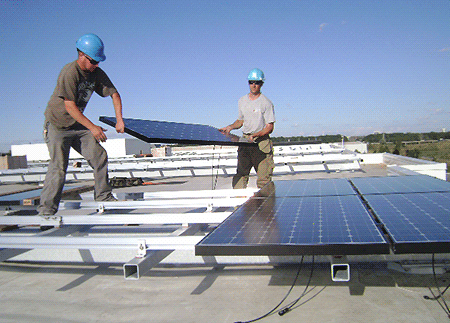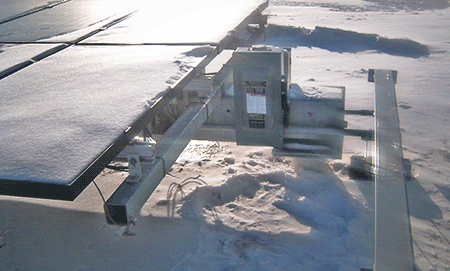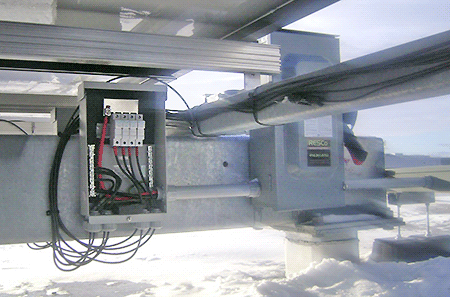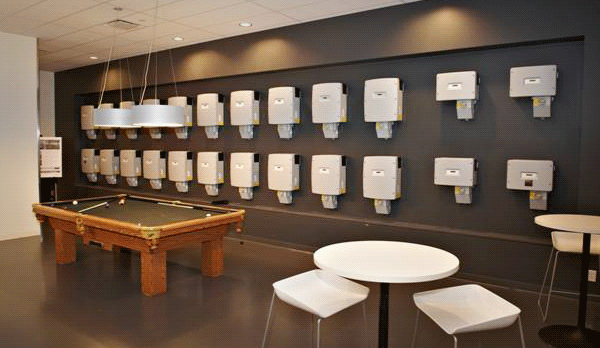This is the second part of our case study on Canada’s largest solar rooftop. Located in Mississauga, just outside Toronto, the building’s construction was completed in Fall 2009. The rooftop solar system became operational in early 2010. It is the first system that feeds electricity into the provincial power grid under the high profile Ontario Feed-In Tariff program. In this installment, we will look at the details of the system design and installation.
First, let’s look at the location of the site. 6696 Financial Drive is in the heart of Mississauga’s financial district. The Google Map below pin points the building, which serves as a call centre for LoyaltyOne, operator of the popular Air Miles reward program. The satellite image shown on the map, at press time, appears to be taken before the solar system was installed as it shows a plain rooftop. According to NASA’s data collected over the past 20 years, the site has an average solar resource of 1,383 kWh/m2 per year before any losses. The data was used as a starting point of the feasibility calculation.
View LoyaltyOne Call Centre in a larger map
The main contractor of the solar system is RESCo Energy, a local renewable energy services firm. According to Kevin Monsour, Vice President of Partner Development at RESCo Energy, most solar rooftop projects are either new construction or retrofit. This project, however, is a mixture of both. The building was designed without the solar rooftop in mind. But the solar system was added on during the construction of the building.
In terms of structural support, the rooftop of the building was not designed to carry the weight of the solar equipment. Instead, the equipment was installed directly above the underlying support column structure of the building. You can think of the panels as anchoring on the structural columns, suspended above the roof.

For the purpose of capturing the most solar energy, the optimal angle of the solar panel placement should be approximately 30 degrees off the rooftop surface. However, due to the anticipated weight of winter snow and the strength of the roof, the panels in this case were oriented directly facing up.


The solar panel model is Sanyo HIT High Conversion Efficiency photovoltaic panels. They have a power output of 205 Watts each. The solar communities give these panels very positive reviews (1, 2). According to Sanyo, their panels can produce 10% more electricity than conventional crystalline silicon solar panels at the same temperature.

The inverter model used is SMA Solar Technology Sunny Boy. Interestingly, LoyaltyOne specifically wanted the inverters to be proudly installed and displayed in the staff room instead of hidden in some electrical rooms as is commonly done. This is something consistent with their core corporate culture which I noticed in my visit. Everyone from top management to junior staff feel engaged with corporate social responsibility and environmental sustainability. Having the inverters displayed on the staff room wall, with their meter readings clearly visible, is a small but highly effective touch that puts a face to their culture. I think more companies should take note of this.

In the next part of this case study, we will look into the financial details of this pioneering project, including the startup costs and operational costs, feed-in tariff rate, and break-even analysis. If you have or are planning to install a rooftop solar system, please share your experience below.
Full Case Study: Part One, Part Two, Part Three, Part Four
Photos courtesy of RESCo Energy and LoyaltyOne.

[…] This post was mentioned on Twitter by Derek Wong. Derek Wong said: Canada’s Largest Solar Rooftop, Case Study Part Two (design, installation) http://bit.ly/bf5be2 […]
if the owner does not want to spend the money on the project and i spend the money and collect rent , what is a fair amount to pay for roof top space for a solar project, thanks
Jim, if I understand you correctly, you are asking how much you should pay a building owner to use their rooftop for you to finance and operate your solar system installed on their rooftop. If so, then this is a matter of putting a value on financial risks. How should the building owner and you divide the reward given that you bear the financial risks. I’m afraid it’s a judgment call and I don’t have a good sense for this. Rather than what’s ‘fair’, perhaps someone familiar with the going rates on the market could share what’s happening out there. Thanks.
Hi Bing / Derek,
Do you know each other ?, I am working with the owner of the building to share the microfit income but He will pay 50% of total installation cost, and also might become our licensed installer.
[…] application, etc. (For details on the solar panels and electrical inverters, see Part One and Part Two of this case […]
This is the perfect blog for anyone who wants to know about this topic. The article is nice and it’s pleasant to read. I have known very important things over here. I admire the valuable advice you make available in your expertly written content. I want to thank you for this informative read; I really appreciate sharing this great.
PACKERS AND MOVERS IN CHANDIGARH @ http://www.toppackersandmoverschandigarh.co.in/
packers and movers in gurgaon @ http://www.bestpackersandmoversgurgaon.in/
packers and movers in noida @ http://www.hariharpackers.in/packers-and-movers-noida/
packers and movers in delhi @ http://www.hariharpackers.in/